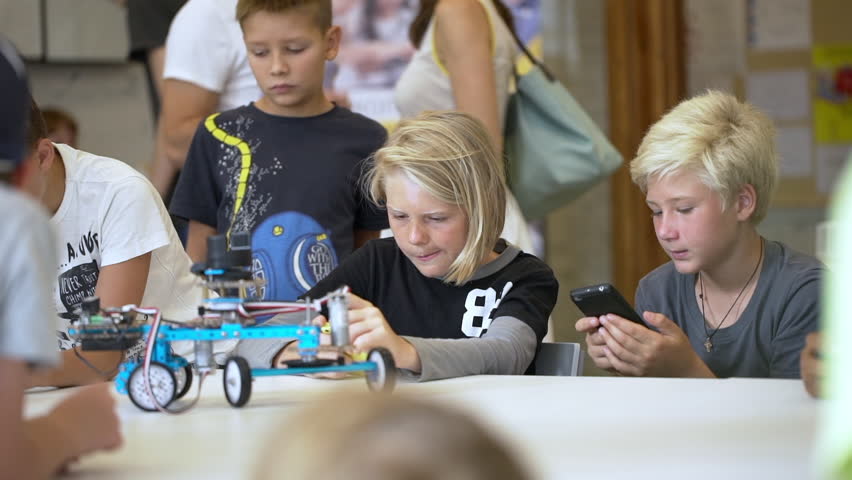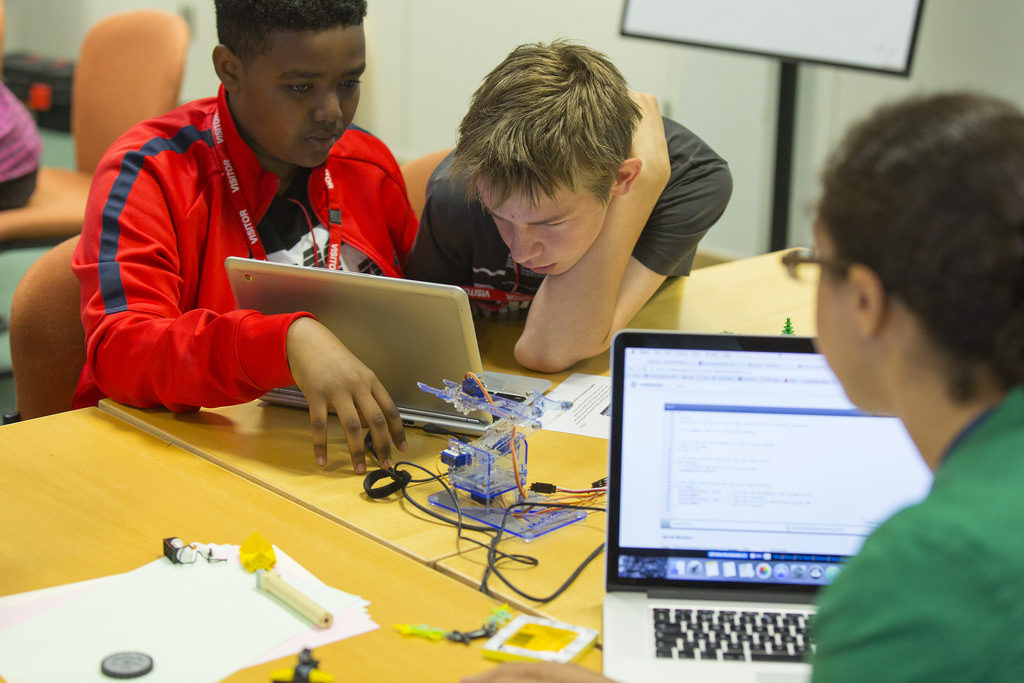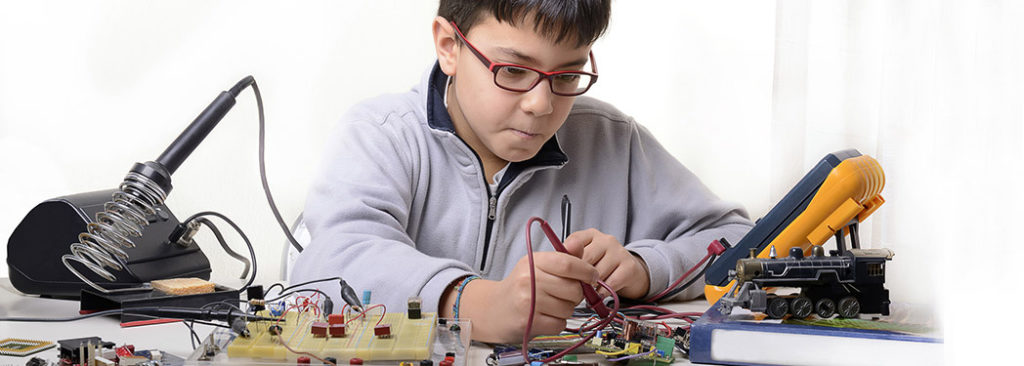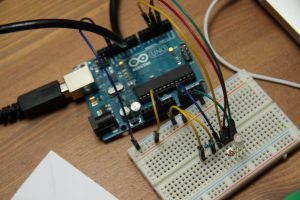Are you starting a Robotics Program? Do you have an existing robotics program that seems to be “dull” or “outdated”? In this article, I will outline some of the critical points to creating a sustainable robotics program, specifically for Middle and High schools.
One of the biggest questions I get from teachers and organizations, alike, is “how much is it going to cost.” And while that is a very important question, something that is more important to consider is “how long will this program last.” Therefore, you have to consider robotics as an investment, and not just some one-time purchase for today’s classes.

You have to consider robotics as an investment: always grow into a robotics kit – not out of it.
Robotics is an Investment
Let’s say you have a $5000 budget for your robotics program. If your program lasts 5 years, then that’s only $1000 per year invested in your program. On the other hand, if you have a $5000 budget for your robotics program and you have to keep buying new kits and equipment because your decision making wasn’t optimal the first time, that $5000 could easily turn into $7500 or $10,000 over the course of 5 years due to poor planning.
Five Steps to Creating a Sustainable Robotics Program
In order to make good decisions, I always recommend following a simple process when you’re starting or improving a robotics program:
- Plan out your program. (Yes, I have to tell people this.)
- Know Your Budget
- Choose the Correct Kit
- Ensure teachers have Proper Training
- Continuously Improve your Program
At the end of this article, you should be well on your way to designing, developing, and implementing a sustainable robotics program for years to come!
Need Help with your Robotics Program?
Arrange a FREE consultation with Robotics Coach, Liz from Learn Robotics. With over 8 years of robotics experience, Liz can help you set up or improve your robotics program!
Step #1 – Plan out your program. Do it. It’s important!
Without a plan, how do you know if you’re heading in the right direction? What is your benchmark? Go into your robotics program with a path for success.
Ok, great. So everyone tells you to create a plan, but what exactly should this plan include?
Some questions to think about during the planning stage are…
- What technologies do we use today that we should be teaching tomorrow?
- What do we want to achieve with this program?
- In 3 years what do we want to accomplish? 5 years? 10 years?
- How much money do we have to spend on robotics? Annual budget? One-time budget?
- Who is involved with this program? (Top to bottom)
Once you’re able to answer these questions, it’s time to form a team.

Gather the stakeholders: teachers, faculty, staff, educators, finance, administration, students, and even parents. Whoever has an opinion about the program, it’s time to let them voice it. Better to hear about XYZ topic now than after you’ve already spent your budget, right?
You have your team, and presumably a list of answers to the questions above. Now, you’ll need to determine what should we teach? What is robotics? How do we teach it?
Out of every question you’ll have to answer during your planning phase, these questions are by far the most difficult to answer. To make things really simple for you, I’ve created a table for you to use.
What should we teach? A simple table about robotics.
Mechanics
Building, Gears, Pulleys, Physics, Motors, Torques
Electronics
Circuit Laws, Schematics, Breadboarding, Components
Programming
Flowcharting, Python, “Blockly”/Scratch, C, C++
Robotics is the combination or integration of Mechanics, Electronics, and Programming. Without all three, you do not have “robotics.” Put extra emphasis on Electronics & Programming, as this is a natural weakness of most schools. Schools typically do a great job with their Mechanics programs, so if you have really strong electronics & programming curriculum, your students will be 10 steps ahead of the game.
Now that we have a plan, it’s time to talk money $$$.
Step #2 – Determine your budget.
When putting together your budget you’ll need to consider not only how much money you have to spend, but how many kits you want to buy. Do you want students to work individually? How about basing your curriculum off of teamwork?
There are typically three categories of budgets for robotics/STEM programs:
#1) Economy-level Budget: Less than $150 per kit
#2) Mid-range Budget: $400-$500 per kit
#3) Elite Budget: $1000 per kit
Oftentimes when I’m creating robotics programs, I’ll see “lump-sum” budgets of $5000, $10,000 or $15,000 dedicated towards robotics and STEM-related initiatives. Just know that even if you have an Elite Budget, it doesn’t mean you absolutely have to buy the $1000 kits. The same is true as if you were to buy a car: just because you can afford that Lamborghini, doesn’t mean you’re going to buy it.
Invest in kits with the features you will use. Not just because it has a million features you could use.

Once you know how much money you have, set aside a portion for unexpected expenses, improvements, and professional development. Use the remainder of the funds to purchase your robotics kits. Now that you know how much money you can spend on kits, it’s time to select your robotics kits.
Step #3 – Choose the correct robotics kit.
There are three big players in the robotics education market right now. And while I have my own opinions as to which kit is best, my goal is to give you as un-biased of an opinion as I can.
The Top 3 Robotics “Brands”
The big three in robotics education are LEGO (Mindstorms EV3/ WeDo 2.0), VEX Robotics (iQ & EDR), and Arduino.
You’ve probably seen these brands around. Maybe you even have a closet full of these kits now? And if you haven’t heard of these kits, it’s a good idea to do a bit of research before choosing the kit for your classroom.
Let’s investigate each of these brands briefly.
Kit Cost: $389.95 each
Ages: 10+, Work in Pairs
Computer/Tablet: Works with both
Software: Computer software plus Tablet App.
Includes everything you’d need to build, program, and test an assortment of robots.
The default software package includes a “drag & drop” programming language which is great for younger students, but is easily outgrown by students Ages 12+.
LEGO Mindstorms EV3 can be programmed using a 3rd Party software called ROBOTC to provide additional and a more advanced programming environment for older students.
Kit Cost: $439.99 each
Ages: 10+, Work in Pairs
Computer/Tablet: Computer
Software: Computer software
Includes everything you’d need to build, program, and test a mobile robot.
If you’re looking for a really rugged kit, then this is your bet. VEX EDR comes with all aluminum pieces that are constructed with screws and nuts. Great kit for teaching everything from mechanics to programming.
The kit is programmed using ROBOTC, which is a C-based programming language.
Kit Cost: $99.99 each
Ages: 10+, Work in Pairs
Computer/Tablet: Computer
Software: Computer software
Arduino is a network of open sourced hardware and software, which means there is a ton of online tutorials and projects available for free.
This is real hardware and electronics, so users have to be careful when wiring up circuits and connecting components. If you connect something incorrectly, you can burn out the component.
Arduino is programmed using the C-language in the Arduino IDE. It is also compatible with the flowcharting language, Scratch.
As you can see, there are a lot of things to consider when choosing a robotics kit. I recommend really investigating and understanding the features and limitations of each of these kits before making your decision.
If you need additional questions answer or want Learn Robotics to create a robotics program for you, schedule a free appointment with us, today!
The #1 thing to consider when choosing a kit is…
… make sure it’s PROGRAMMABLE using WRITTEN CODE (not function blocks or drag & drop).
If you have a kit that allows you to program it using a written language (C, C++, Python), then that will hold your robotics program over from Middle school through High school. Students can grow into that kit, and not out of it.
Step #4 – Ensure Educators & Teachers have proper training.
Your robotics program is only as good as the teachers teaching it.

Robotics is a very interdisciplinary subject. You have to know how to build things (correctly); wire up sensors (correctly); and program (correctly). Notice how many things you have to be able to do correctly.
Since the goal of a robotics class is to promote STEM careers, you don’t want to rush into a program where teachers don’t know how to inspire youth with challenging activities. You also don’t want to put teachers in a situation where they’re thrown a bunch of new technology and don’t know how to properly use it.
There’s nothing worse than investing thousands of dollars in robotics kits that end up sitting on a shelf in some storage closet.
Learn Robotics has invested hours into designing and creating content specifically for Robotics Educators. We launched our RoboED training certification to properly train and educate teachers on programming, electronics, and robotics fundamentals. Rather than reading through PDF lesson plans, our certification is customized and individualized for each teacher’s classroom.
We even have LIVE, online lessons for educators to take from the comfort of their homes.
Invest in your educators so that your robotics program is strong from the start. Buying just the kits is not enough to create a long-lasting impact. You must invest in your program’s operation. This will ensure that your program is catered towards both the beginner and advanced students, alike.
Step #5 – Continuously Improve your Robotics Program

Now that your robotics program is planned, the kits are procured, and your staff is trained, you must actively improve your program. There’s nothing worse than teaching the same content over and over again. And, the best part about robotics, is no two classes have to be the same.
Sample Lessons to Upgrade Your Robotics Program
There are thousands of topics you can cover with robotics. Here are just a few ideas to get your creative juices flowing:
- Torque using Motors & Gear Trains
- Create a custom Library using the Arduino IDE
- Build a conveyor that sorts LEGO bricks
Improving your program doesn’t have to cost a lot of money either. A very cost-effective (and typically free) thing that I recommend is changing your programming language. If you’ve purchased a flexible kit that can be programmed in multiple languages, move from a “drag & drop” environment to programming using Python or C. Remember, majority of engineering industry doesn’t use “drag & drop” to code. Engineers write the code themselves using written programming languages.
Lastly, I wish you the best of luck in developing or improving your robotics program! If you have any questions or comments, feel free to leave them in the comment section below.
If you need individualized assistance with designing curriculum or improving your existing robotics program, feel free to contact us! We have a variety of robotics and STEM curriculum solutions for any budget.
BONUS: Presentation from STEM Innovation Academy
Learn Robotics was invited to present a live seminar on Implementing Sustainable Robotics programs for Grades 6-8 at the STEM Innovation Academy (Atlanta, GA). While this written guide is more comprehensive than this lecture, we’ve decided to include it for your reference.







